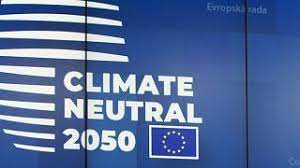Why the EU’s 2050 climate neutrality target is 10 years too late

Brussels: Global science says that rich nations should achieve climate neutrality no later than 2040, write Leon de Graaf, Dominika Floriánová, Antoine Grall and Ella Oksala.
Authors of this article all work in the climate practice of #SustainablePublicAffairs, a Brussels-based public affairs agency.
Brussels is back from its summer holidays. With less than a year to go before the EU elections that will see a new European Parliament and European Commission, and the Fit-for-55 package over and done, one would think that everyone focused on EU climate policy can sit back and relax.
That couldn’t be further from the truth. That’s because the current European Commission is mandated by the European Climate Law to set up a climate target for 2040, in other words: An intermediate goal between its current 2030 and 2050 targets. The proposal should be put forward by the first quarter of 2024.
To gather insights for the 2040 climate target, the Commission before the summer held a public consultation with input from more than 900 organisations and individuals.
While there are some pushing for the 90-95% greenhouse gas reduction target that is in line with the recommendations of the European Scientific Advisory Board on Climate Change, others are pushing back and only calling for a 70-80% reduction target.
That is simply calling for a linear line to be drawn between the 2030 target of 55% and the current EU climate neutrality target by 2050.
The problem with the linear line ambition is that it’s based on the outdated assumption that an EU climate neutrality target by 2050 is ambitious. The March 2023 report by the Intergovernmental Panel on Climate Change (IPCC) shows that climate frontrunners such as the EU should bring their CO2 emissions to zero much earlier than 2050.
This is because global climate neutrality is needed by 2050, which means rich regions such as the EU should decarbonise faster. This is crucial in particular from a social fairness perspective: It would compensate for developing regions that need more time, and it’s fair because the EU is historically responsible for more than 20% of CO2 emissions since 1750.
If the EU cannot follow the science itself, then how does it expect to lead by example and ask others at the international climate negotiations (COP28) to follow suit?
While a 2040 climate neutrality target would be more ambitious than aforementioned findings of the European Advisory Board, the Advisory Board also recognises that this would still not reflect a fair share as it does not take into account ethical principles such as ability to pay and historical emissions.
Furthermore, the current EU energy and climate policy framework already foresees that almost half of EU emissions, covered by the EU Emissions Trading System (EU ETS), reaches climate neutrality by around 2040. This is because the so-called linear reduction factor will reduce the annual number of CO2 allowances coming into the system by 4.2% as of 2024, and by 4.4% as of 2028.
Continuing this beyond 2030 would allow the sectors covered by the EU ETS to reach climate neutrality before 2040. So we are not starting from scratch: The challenge is now to find ways for sectors not covered by the EU ETS to achieve this too.
The EU’s current 2050 climate neutrality target is therefore obsolete and should be sped up to 2040. And by 2050, the EU should have become a carbon sink for the rest of the world by having found ways to reach deep levels of negative GHG emissions.
Unfortunately the departure of Green Deal defender Frans Timmermans from Brussels raises concerns in this regard, as it was rumoured the 2040 climate target was going to be his legacy project. Judging from the recent remarks by newly-appointed Green Deal Vice President Maroš Šefčovič, it is unfortunately unlikely that the current European Commission will propose a climate neutrality target by 2040.
It’s therefore up to ambitious voices in the European Parliament and elsewhere to step up to the plate. A 2040 climate neutrality target would also be in line with remarks made by the UN Secretary General in March 2023, who called upon developed countries to commit to reaching net-zero as close as possible to 2040.
And beyond these remarks, it’s only fair for young and future generations. Even if the world reached climate neutrality by 2050, the IPCC estimates that this only increases our chances to stay within a 1.5 degrees scenario world to 50%. In other words, the chances of avoiding seriously negative climate impacts for young and future generations would be reduced to a coin flip. Far too risky, so it’s the very least that we can do.





